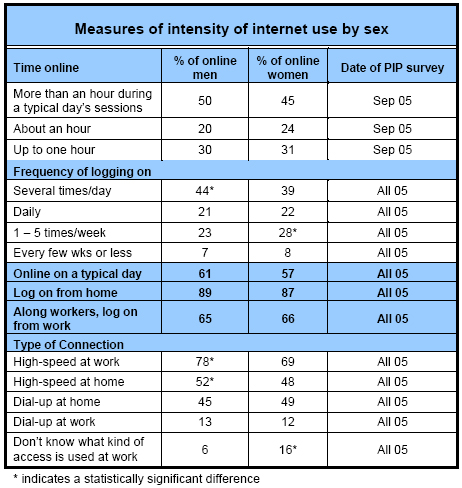Overall, men spend slightly more time online and go online more frequently than women.
Various measures of intensity of internet use suggest men are slightly more engaged with their lives online than women. Measures of overall time spent online, frequency of going online, and likelihood to go online on any given day are all stronger for men than women. More men also have fast internet access, presumably allowing them more productive time online with less waiting. 6
Overall, men spend slightly more time online than women.
On a typical day in 2005, 61% of men and 57% of women went online. Predictably, use of the internet on a typical day declines as people grow older; younger users are more likely to go online on a typical day. Men and women follow this pattern, with the surprising exception of the youngest men. In aggregate figures from 2005, some 57% of men ages 18 – 29 go online on an average day, fewer than the 60% of the youngest women and also fewer than the 65% of men ages 30 – 49 and 61% of men, ages 50 – 64.
Men go online more frequently than women.
In 2005, more wired men, 44%, go online several times a day than women, 39%. About a fifth of both men and women go online once a day. Significantly more women go online less frequently.
Among the most frequent users, those who go online several times a day, the difference between sexes flattens the younger the cohort is. Among those over age 65, 31% of men and 21% of women go online at least several times a day. The most frequent users among those ages 50 – 65 include 48% of men and 38% of women. The gap between men and women closes for those under age 50, and the differences are no longer significant. Of those ages 30 – 49, the most frequent users include 47% of men and 42% of women. And among the youngest users, age 18 – 29, it includes 40% of men and 38% of women. Data from teen users collected in November 2004, pushes this one step further: 24% of both girls and boys generally go online several times a day.
Broadband users log on more frequently, and men more than women. White men log on more frequently than white women and non-white men.
Broadband users go online more frequently than dial-up users, but the distinction between sexes remain. Among broadband users, significantly more men, 59%, than women, 53%, go online several times a day.
White men log on more frequently than white women and non-white men.
White men are significantly more likely to be most frequent users than most other groups. White men, 46%, use the internet at least several times a day compared with white women, 39%; to black men, 34%, or English-speaking Hispanic men, 33%. They log on more than black women, 35%, and English-speaking Hispanic women, 40%, although not significantly so.
There are no significant differences between men and women among blacks or English-speaking Hispanics for any measure of frequency.
Men and women are equally likely to access the internet from home, although men do it more often. Men and women are equally likely to log on from work.
In 2005, 89% of men and 87% of women went online from home. Further, online patterns at home mirror online patterns overall: Men log on more frequently than women, and they are more likely to go online on an average day.
In significant numbers, more men, 31%, than women, 26%, log on from home at least several times a day; more women than men log on less than daily; and on a typical day, more men, 50%, than women 44%, were likely to go online from home.
Men and women are equally likely to log on from work.
Among those internet users who work full-time or part-time, equal numbers of men, 65%, and women, 66%, log on from work.
Among those who log on from work most often, at least several times a day, there were significantly more men, 56%, than women, 49%. Men and women logged on from work daily in equal numbers, 19%. More women, 31%, than men, 24%, logged on at work less often than once a day.
On a typical day, men and women who go online at work are equally likely to do so.

Men are more likely to have high-speed connections.
In 2005, more men, 52%, than women, 48%, say they have high speed internet connections at their homes, a difference that is small but statistically significant. These numbers are up dramatically from 2002, when 26% of men and 20% of women said they have high speed connections at home.
At work, a greater overall number of users, 74%, say they have high speed connections, although 11% said they either don’t know the answer, or refused to answer.7 Significantly more men, 78%, than women 69% said they have high speed connections at work. However, a very large 16% of women, compared with 6% of men, said they didn’t know the answer or refused to answer the question.


